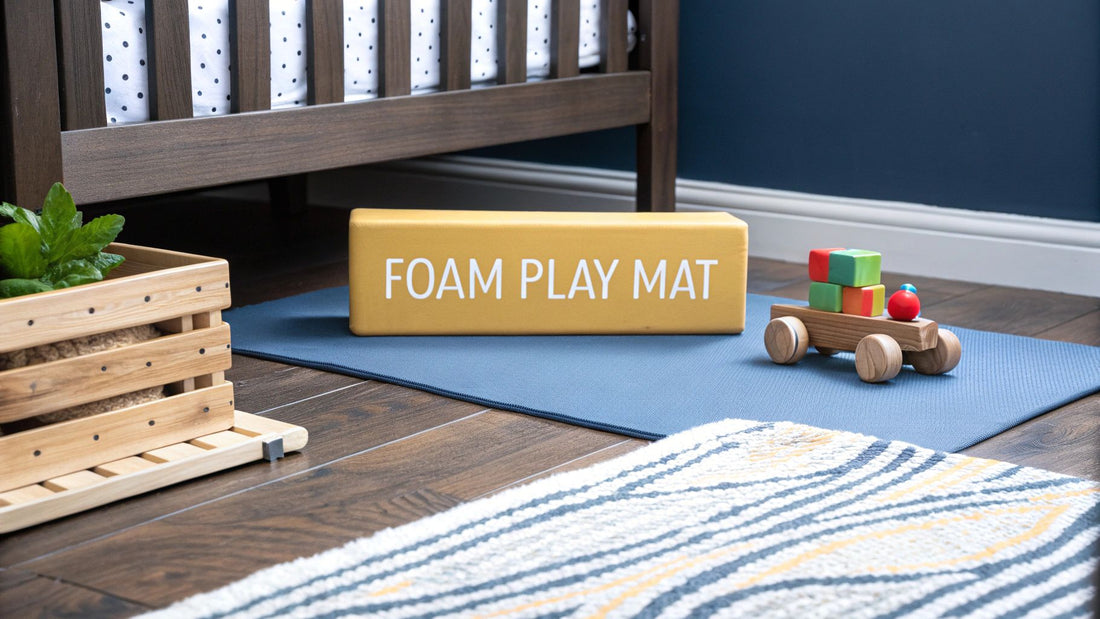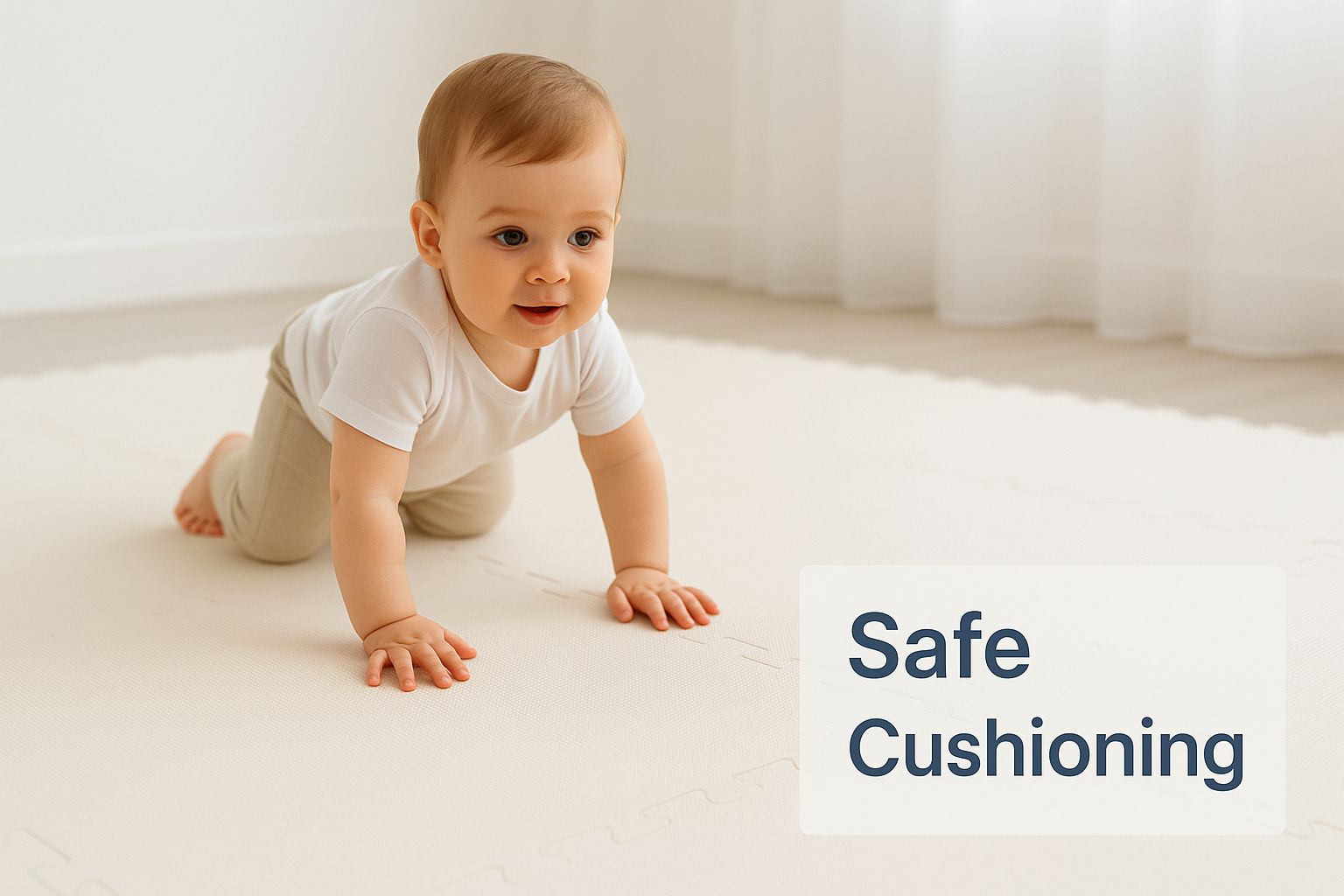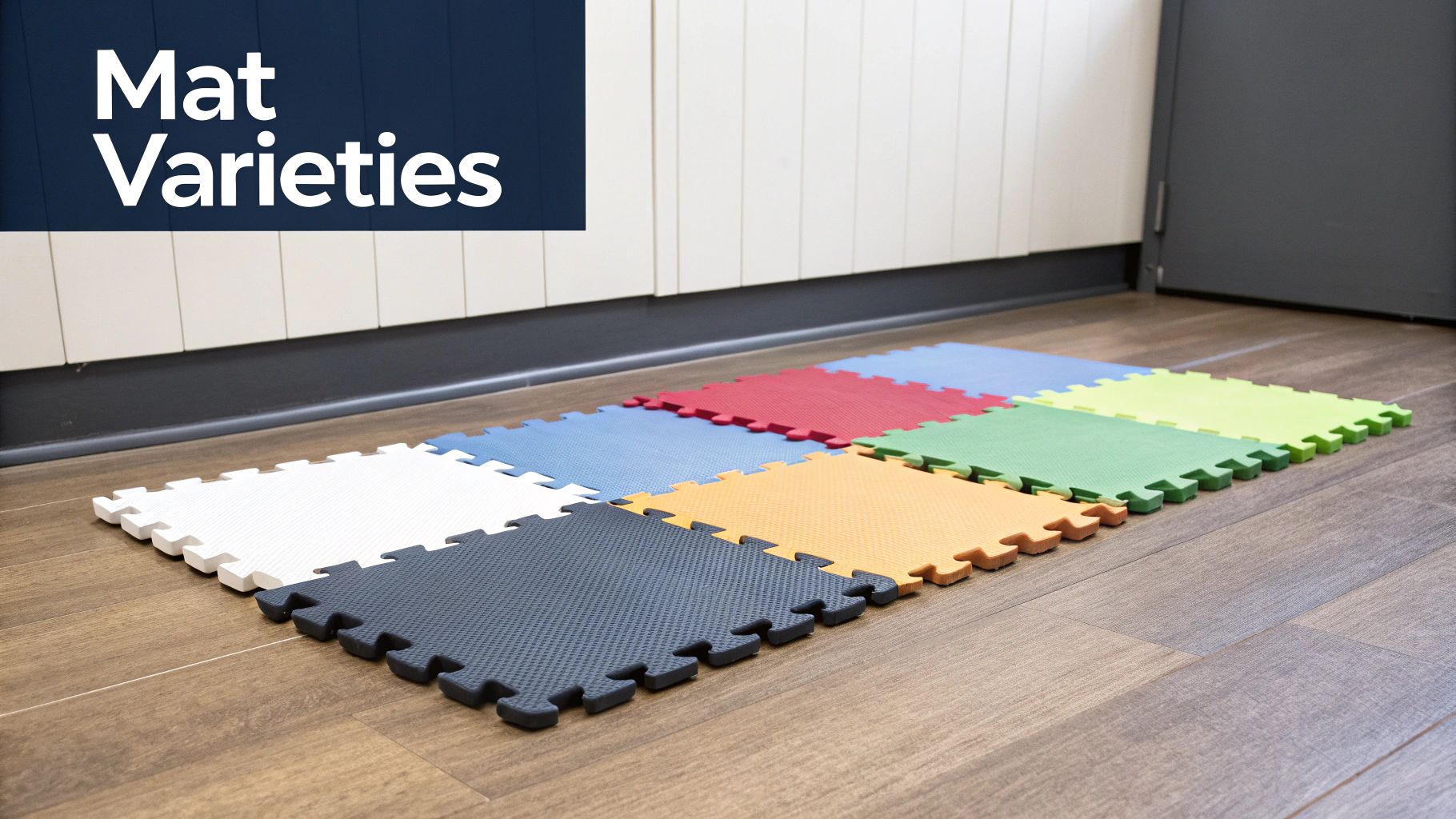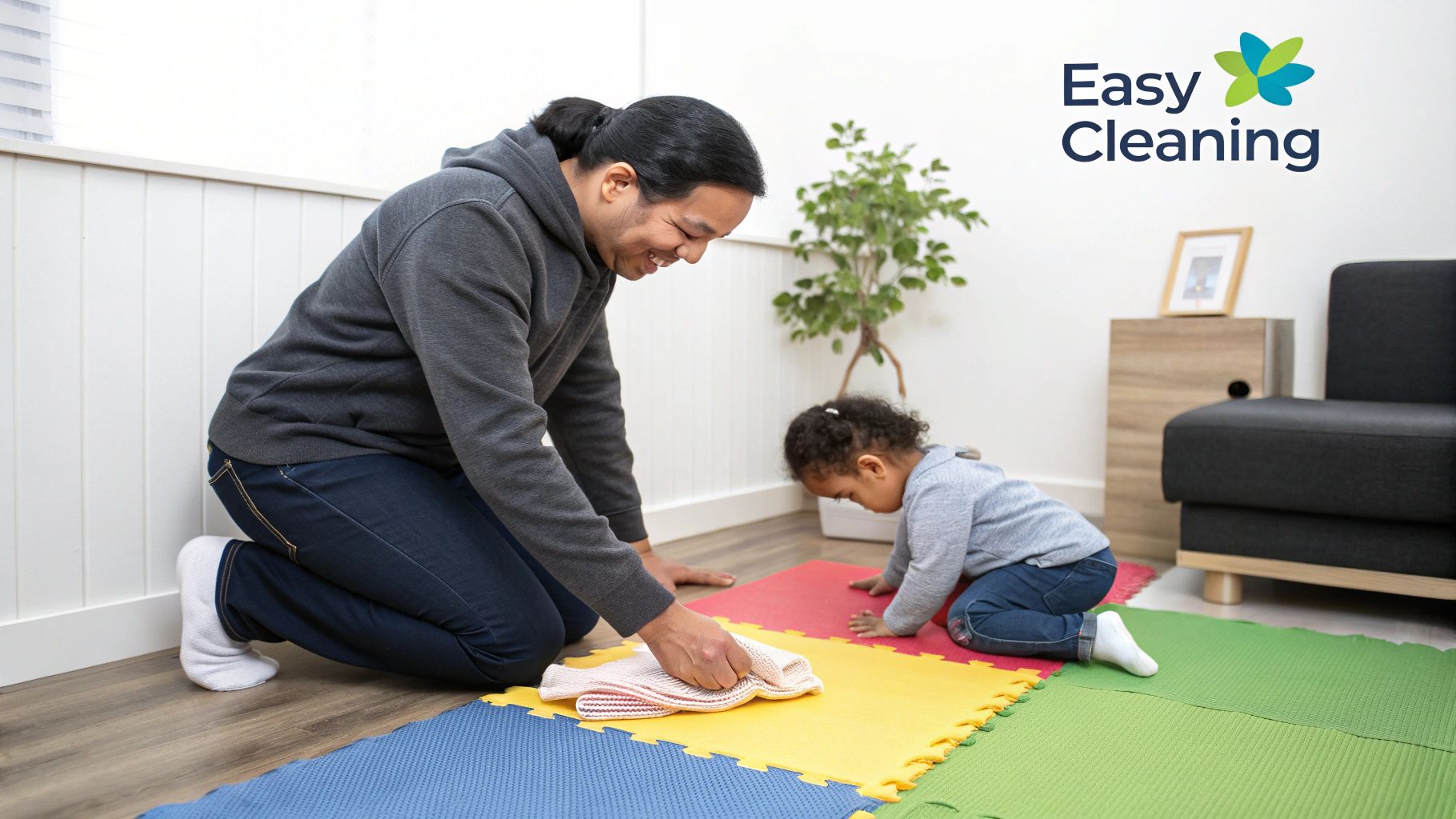
Your Guide to the Best Foam Play Mat for Kids
Share
A foam play mat is a soft, cushioned surface made to give babies and toddlers a safe, comfy spot to play and explore. Think of it as your little one’s first personal gym—a dedicated space designed for safety, comfort, and hitting those big developmental milestones.
The Foundation for Safe Exploration
A foam play mat is so much more than just a soft spot on the floor. It’s really a foundational tool for early childhood, creating a controlled environment where your baby can safely start to figure out their world. From those wobbly first attempts at tummy time to the triumphant first steps, the mat provides a forgiving surface that cushions the inevitable tumbles and bumps against hard flooring.
This designated play zone offers more than just physical protection. It carves out a clean, hygienic area that is exclusively for your child, free from the dirt and allergens that live on regular household floors. This is a huge deal for infants who spend most of their time close to the ground, exploring everything with their hands and mouths.
A dedicated play mat doesn't just protect your child; it empowers them. It gives them a defined space to call their own, fostering a sense of independence and encouraging them to test their physical limits without fear.
Benefits for Child and Parent
For children, the advantages are all about development. The cushioned surface supports them as they learn to roll, sit up, and crawl, making it easier to build those crucial motor skills. Many mats also feature engaging colors and textures that provide sensory stimulation, which is a key part of their cognitive growth.
For parents, the benefits boil down to practicality and peace of mind. A foam play mat is brilliant for containing toys and messes, which simplifies cleanup and helps keep play areas organized. Its role in creating a safer home is becoming more and more recognized by families, and you can see that in the market's growth.
In fact, the baby play mat market was valued at USD 1.5 billion in 2024 and is forecasted to hit around USD 2.8 billion by 2033. This surge shows just how important these safe play surfaces have become to modern parents.
Let's break down the advantages for both you and your little one in a quick table.
Key Benefits of a Foam Play Mat at a Glance
| Benefit for Child | Benefit for Parent |
|---|---|
| Cushions falls during crawling and walking practice. | Provides peace of mind knowing your child is safer. |
| Supports development of gross motor skills. | Creates a defined, easy-to-clean play area. |
| Offers sensory stimulation with colors and textures. | Contains messes and keeps toys in one spot. |
| Provides a clean, hygienic surface for play. | Portable and easy to store or move around the house. |
| Creates a sense of a personal, independent space. | A stylish addition that can protect your floors. |
As you can see, it's a win-win. A play mat is a simple addition that makes a big difference for everyone.
Ultimately, bringing a foam play mat into your home helps build a more nurturing environment. It's a key piece when it comes to creating the perfect nursery for your little one, blending safety, function, and developmental support into one essential item.
Exploring the Different Types of Foam Play Mats
When you start looking for a foam play mat, it might feel like there are a million options out there. But really, it all comes down to three main styles. Getting to know the differences will make it so much easier to pick the perfect one for your home and your family.
Let's break down the main categories to see how they stack up. Each type has its own perks, whether you're prioritizing portability, easy cleaning, or a specific size.

This image really drives home that a play mat is more than just a soft spot on the floor—it's a safe foundation for your child's entire world of exploration.
Interlocking Tiles
You’ve definitely seen these before. Interlocking foam tiles are like a giant, soft puzzle you piece together on your floor. Their biggest selling point is that modular design. You can customize the size and shape to fit any space, from a tiny corner in the nursery to the entire playroom.
This flexibility is a huge reason they’re so popular. The global baby play mat market was valued at around USD 1.09 billion back in 2025 and is still on the rise, largely thanks to customizable options like these tiles. Parents love being able to create a unique space for their kids. You can learn more about this growth in the full research on baby play mats.
The downside? All those seams between the tiles are magnets for crumbs, dust, and spills. This makes them a bit more of a hassle to deep clean compared to a seamless mat.
- Pros: Highly customizable for any size or shape, easy to replace a single damaged tile, and they often come with fun letters or numbers.
- Cons: The seams collect gunk, and curious little hands might be tempted to pull the pieces apart.
One-Piece Roll-Up Mats
For parents who put hygiene first, the one-piece roll-up mat is a game-changer. It’s exactly what it sounds like: a single, seamless piece of foam. With no cracks or crevices, the smooth surface is incredibly easy to wipe clean after spills or messes.
A lot of these mats are also reversible, giving you two different designs in one, which is a nice little bonus for changing up the look of your space. When playtime is over, you just roll it up and stash it in a closet or behind the couch.
A one-piece mat’s superpower is its seamless surface. It completely eliminates the crumb-trapping issue you get with interlocking tiles, meaning a cleaner play area with way less effort.
The only real limitation here is the fixed size. You can't adjust the dimensions like you can with tiles, so you’ll want to pull out the measuring tape and make sure it fits your space before you buy.
Foldable Mats
Foldable mats are the brilliant middle ground between the huge coverage of a one-piece mat and the need for easy storage. They’re made from a single large piece of foam but have built-in, accordion-style creases that let you fold them down into a neat, compact rectangle.
This design is perfect for families who are always on the move or just need to reclaim their floor space regularly. You can easily fold one up and take it to Grandma's house or keep it in the car for park days. When laid out, they offer a generous, cushioned play area, but they shrink down to a surprisingly small size for storage.
While the creases can catch a little dirt, they're still much, much easier to clean than the dozens of seams on a tile mat.
Decoding Materials and Critical Safety Standards
As a parent, nothing matters more than your child's safety. When you're choosing a foam play mat, you're picking the very foundation of your little one's play world. So, it’s only natural you want to know exactly what it's made of. Let's cut through the technical jargon and figure out what really matters.
At its heart, a foam play mat is made from one of a few common materials. You can think of them like different recipes, each one creating a unique feel, durability, and safety profile.

Common Foam Mat Materials
The two most popular kids on the block are EVA and XPE foam. They might sound like alphabet soup, but the differences are pretty straightforward.
-
EVA (Ethylene Vinyl Acetate): You've probably seen this one before. It's a common, rubbery material often used for those interlocking puzzle-piece mats. EVA is known for being lightweight and offering good shock absorption, which is great for tumbles. The catch? Some lower-quality EVA foams can contain a chemical called formamide. It’s crucial to look for mats that are certified formamide-free.
-
XPE (Cross-linked Polyethylene): This is often seen as the premium option. XPE foam is denser, more durable, and has a smoother, easier-to-clean surface. Better yet, its production process doesn't involve formamide, making it a go-to choice for parents who want a non-toxic mat right out of the box. You'll usually find XPE used in one-piece and foldable mats.
You might also run into PVC (Polyvinyl Chloride) mats, though they are less common these days. While PVC is durable and super easy to wipe down, it can contain phthalates and other not-so-great chemicals unless it has certifications proving otherwise. Because of this, most parents now lean toward trusted EVA or XPE options.
Navigating Safety Certifications
Think of safety labels as your secret decoder ring for product safety. These certifications are your best proof that a play mat has been independently tested and given the green light for kids.
A safety certification isn't just a sticker; it's a promise. It signifies that the product has passed rigorous testing for harmful chemicals and physical hazards, ensuring it’s a truly safe surface for your child to play on.
When you're shopping, keep an eye out for these key indicators of a safe, high-quality mat:
- ASTM F963-17: This is the gold standard for toy safety right here in the United States. It ensures the mat is free from heavy metals and other nasty substances.
- EN71: This is the European equivalent of the ASTM standard, covering a huge range of safety criteria. A mat with this certification meets some of the highest international safety requirements.
- BPA-Free and Phthalate-Free: These labels are your assurance that the mat doesn't contain common plasticizers known to be harmful to a child’s development.
The demand for safe play surfaces is growing fast, pushing companies to create better, safer products. Choosing a safe mat is the first step, and this principle applies to everything your child interacts with. If you're building out your little one's space, you might also be interested in our guide on selecting non-toxic kids' furniture.
How to Choose the Right Foam Play Mat for Your Home
Picking out the perfect foam play mat can feel like a huge deal, but it really doesn’t have to be. If you focus on just a few key things, you can easily find a mat that fits your space, matches your style, and gives your little one the support they need.
Let’s walk through a few essential points that will help you narrow down the options. Think of it as a simple checklist to turn that overwhelming feeling into a confident choice.
Size and Thickness
First up, grab a measuring tape. It sounds obvious, but a mat that's too small won't give you the coverage you need, while one that's too big will just swallow the room. Decide where the mat is going to live—the nursery, the living room, a corner of the kitchen?—and get a clear idea of the dimensions you have to work with.
Thickness is just as important, especially when it comes to safety and comfort. It's all about cushioning those inevitable tumbles.
- For Infants (0-6 months): A mat that’s about 0.4 to 0.5 inches (around 1 cm) thick is perfect. It gives just enough cushion for tummy time and learning to roll over without being too squishy.
- For Crawlers and New Walkers (6-18 months): Once your baby is on the move, you'll want a bit more padding. A mat between 0.5 to 0.8 inches (1.2 to 2 cm) thick provides fantastic shock absorption for those wobbly first steps and crawling adventures.
A thicker mat is a real game-changer if you have hard floors like tile or hardwood. It's that extra peace of mind you need when they start exploring.
Design and Stimulation
Believe it or not, the look of your play mat matters. It can either blend right into your home decor or become a fun, vibrant centerpiece for your child’s play zone. It really just comes down to your personal taste and what you think your child will enjoy.
Minimalist, neutral-toned mats are super popular right now, especially for modern living spaces. They create a calm, clean look while still offering a safe spot to play. On the other hand, brightly colored mats with letters, numbers, or cute animal patterns can be a great tool for sensory and cognitive learning. These interactive designs can spark so much curiosity as your child grows.
The best design is one that balances what you want to look at every day with what your child will love playing on. It's all about creating a happy, harmonious space for the whole family.
Ease of Cleaning
Let's be real for a second: your play mat is going to see its fair share of spills, crumbs, and who-knows-what-else. A mat that’s a pain to clean will become your worst enemy. This is where the material and construction really come into play.
One-piece or foldable mats with a smooth, non-porous surface are the absolute easiest to maintain. Most of the time, a quick wipe-down is all you need to handle daily messes. Interlocking tile mats are great for customizing size, but all those little seams can trap dirt and crumbs, meaning a deep clean takes more effort.
Always check if the mat is made from a waterproof material like XPE foam. This will stop liquids from soaking in, which prevents stains, damage, and even mold. Trust me, choosing a mat that’s easy to clean isn't just about convenience—it's about keeping a hygienic play space for your baby. It’s one of those little things that makes a huge difference in your day-to-day life.
Maintaining Your Mat for Longevity and Hygiene
A good foam play mat is a real investment. You're not just buying a soft spot for your child to land; you're investing in their comfort and safety. So, it only makes sense to protect that investment with a simple maintenance routine that keeps it hygienic, vibrant, and ready for years of play. The good news? It's not complicated.

This focus on clean, safe spaces for kids is a big reason why the play mat market is booming. Valued at USD 1.8 billion in 2024, the global baby play mat sector is on track to hit USD 2.9 billion by 2033. It’s a trend that shows just how much parents care about these details. If you're interested in the numbers, you can learn more about the baby play mat market growth and the data behind it.
Daily Wipes Versus Deep Cleaning
I like to think about mat care in two easy categories.
First, you have your Daily Wipes. These are for the everyday messes—the inevitable spit-up, scattered crumbs, and juice spills. For these little clean-ups, a soft cloth with a bit of water and a single drop of mild dish soap is all you need. It’s gentle but gets the job done.
Then there’s the Deep Clean. This is something you’ll probably want to do weekly, or maybe after a playdate gets particularly messy. Just mix up a solution of equal parts water and white vinegar. It's a fantastic natural disinfectant that tackles germs without any harsh chemicals.
One thing to always avoid: abrasive sponges, anything with bleach, or strong solvents. These will wreck the mat's protective top layer, causing the colors to fade and the foam to break down way too soon.
Tackling Common Mat Issues
Even with the best cleaning habits, a few common problems can pop up. Knowing how to handle them will keep your mat looking brand new.
- Preventing Sun Discoloration: Direct sunlight is the enemy of vibrant colors. If your play area gets a lot of sun, try rotating the mat every so often or just drawing the curtains during the sunniest part of the day.
- Managing Furniture Indentations: Heavy furniture will absolutely leave dents in the foam. If you need to place a piece of furniture on the mat, use furniture coasters to spread the weight out. For dents that are already there, a little trick is to gently warm the spot with a hairdryer on low—it can sometimes help the foam bounce back.
- Storing Your Mat Correctly: If you ever need to pack the mat away, always roll it up loosely. Folding it tightly will create permanent creases and ruin that perfectly smooth surface you love.
Creative Uses for Your Foam Play Mat as Kids Grow
Think of your foam play mat as a long-term investment. It's not just a baby product that you'll pack away after a year. It’s designed to grow right alongside your child, transforming from a simple baby essential into something the whole family can use. Its usefulness goes way beyond just tummy time and those first wobbly steps.
As your baby becomes a toddler, the mat becomes the perfect spot for building elaborate block towers. It provides a stable, forgiving surface when those towering creations inevitably come tumbling down. It also works great as a designated mess-proof crafting zone, protecting your floors from the dreaded trio of paint, glitter, and modeling clay.
From Play Zone to Family Hub
The mat’s comfort isn't just for kids, either. It easily transitions into a cozy reading nook for quiet afternoons. We’ve even seen parents use it as a comfortable surface for their own yoga or stretching exercises. This kind of adaptability is what gives it lasting value in a busy home.
- Building Adventures: If your mat has interlocking tiles, the fun really multiplies. Kids can build forts, tunnels, and imaginative obstacle courses, which is a fantastic way to burn off energy indoors. Our guide to indoor play tents has even more ideas for creating these fun little spaces.
A foam play mat’s true value is in its ability to adapt. It’s not just a product for one stage of childhood; it’s a piece that evolves with your family’s changing needs, from a safe baby gym to a dynamic toddler playground.
This long-term usability is a huge plus for many families, especially as more parents look for eco-friendly and non-toxic products. People want durable, safe items that will last, which explains why the foam play mat market keeps growing. You can dig into more insights about this growing market on DataHorizzon Research if you're curious.
Your Top Questions About Foam Play Mats, Answered
Stepping into the world of baby gear can feel overwhelming, and it's natural to have a few questions. Let's clear up some of the most common things parents ask when choosing and using a foam play mat for their little one.
Are Foam Play Mats Safe for a Newborn?
Yes, a good quality foam play mat is a great, safe space for a newborn, as long as you know what to look for. The number one priority is making sure the mat is certified non-toxic and totally free from nasty chemicals like BPA, phthalates, and formamide.
Just as important is the firmness of the surface. A mat that’s too soft or squishy can be a suffocation risk, which is a real concern during tummy time. A firm, flat surface gives newborns the stable support they need to start building that crucial neck and core strength. And of course, always keep a close eye on your baby during playtime, no matter the surface.
The right foam play mat creates a safe, controlled little world that supports motor skill development right from day one. It’s a clean, cushioned space made just for them.
Can I Put a Foam Play Mat on Top of My Carpet?
Absolutely! In fact, putting a foam play mat over a carpeted floor is a fantastic idea. It instantly creates a surface that's more stable, waterproof, and a breeze to clean—protecting your carpet from the spit-up, spills, and messes that are just part of life with a baby.
This little trick also adds an extra layer of soft cushioning, which is perfect for babies who are just learning to sit up or crawl. To keep it from slipping and sliding, try to find a mat with a non-slip backing that will grip onto the carpet fibers and stay put. Just give the carpet a quick check to make sure it's clean and dry before you lay the mat down.
What’s the Best Thickness for a Foam Play Mat?
The perfect thickness really depends on your child's age and what kind of floors you have, but a good sweet spot is usually between 0.4 inches (1 cm) and 0.8 inches (2 cm).
- For Babies (0-12 months): Something around 0.5 inches thick gives them plenty of cushion for the little tumbles that happen when they’re learning to sit, roll, and crawl.
- For Toddlers or Hard Floors: If you’ve got hard flooring like tile, concrete, or wood, a thicker mat of 0.6 inches or more will provide that extra shock absorption for more energetic play.
Try to steer clear of mats that are overly thick and plush. While they might look cozy, they can actually be pretty unstable for a toddler who is still getting the hang of balancing and learning to walk.
At Ocodile, we're all about creating products that grow with your family, blending safety, smart design, and a touch of style. Come explore our collection of child-friendly furniture and play essentials made to support your little one’s big adventures. Discover the perfect additions to your home at Ocodile.








